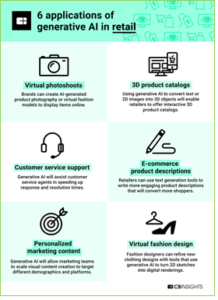Table of Contents
Context: Big tech companies such as Google and Microsoft are integrating generative AI technology into their products following the success of OpenAI’s ChatGPT.
About Generative AI
- It refers to a category of artificial intelligence (AI) algorithms that generate new outputs based on the data they have been trained on.
- Unlike traditional AI systems that are designed to recognize patterns and make predictions, generative AI creates new content in the form of images, text, audio, and more.
Example of Generative AI: ChatGPT, Dall-E and Bard
ChatGPT:
- ChatGPT is an AI-powered chatbot application built on OpenAI’s GPT-3.5.
- OpenAI has provided a way to interact and fine-tune text responses via a chat interface with interactive feedback.
Dall-E
- Dall-E is an example of a multimodal AI application that identifies connections across multiple media, such as vision, text and audio.
Google Bard
- Google Bard is a new chatbot tool, designed to simulate conversations with a human and uses a combination of natural language processing and machine learning, to provide realistic, and helpful responses to questions you might ask it.
- It uses LaMDA (Language Model for Dialogue Applications) technology.
- It’s built on top of Google’s Transformer neural network architecture, which was also the basis for other AI generative tools, like ChatGPT’s GPT-3 language model.
Application of Generative AI
- Note making: It can take notes during a virtual meeting, can draft and personalize emails, and it can create slide presentations.
- Dubbing: Improving dubbing for movies and educational content in different languages.
- Audio & Visual: Creating photorealistic art in a particular style and improves product demonstration videos.
- Suggesting new drug compounds to test.
- Optimizing new chip designs.

Significance of Generative AI
- Copywriting: Automates the manual process of writing content, reducing the effort of responding to emails, summarizing complex information and simplifying the process of creating content in a particular style.
- Arts: Generative AI is frequently utilized in creative sectors, specifically to create art and generate images.
- These models can be trained on a large number of paintings and later be used to generate new ones with similar features and slight variations in style.
- Healthcare: Generative AI is being used in healthcare applications for its ability to revert MRI scans into CT scans.
- Generative adversarial networks (GANs) are learning to create fake versions of underrepresented data, which is later used in training and developing a model.
- Sound generation: Generative AI can even work with audio data, altering the sound of musical genres or human voices.
- Image instance creation: It has the ability to produce fake realistic-looking photographs of people.
- Gaming: Generative AI can provide new experiences for players by building immersive worlds for them to explore, like cities, forests, and even new planets.
- Media and advertising: Generative AI can modify content creation through super-resolution.
Concerns
- Fake News: Cybersecurity researchers expressed concern that generative AI could allow bad actors, even governments, to produce far more disinformation than before.
- It can provide inaccurate and misleading information.
- It is more difficult to trust without knowing the source and provenance of information.
- Plagiarism: It can promote new kinds of plagiarism that ignores the rights of content creators and artists of original content.
- Disrupt business models: It might disrupt existing business models built around search engine optimization and advertising.
- Fake narrative: It makes it easier to claim that real photographic evidence of a wrongdoing was just an AI-generated fake.
- Impersonation: It could impersonate people for more effective social engineering cyber attacks.
- Short-cut learning: Students producing AI-drafted essays undermines the hard work required for them to learn.
Conclusion
- Generative AI is a powerful tool that has the potential to revolutionize several industries.
- With its ability to create new content based on existing data, generative AI has the potential to change the way we create and consume content in the future.


 How African Reserves Eliminated Rhino Po...
How African Reserves Eliminated Rhino Po...
 Why India Needs Its Own Economic Model?
Why India Needs Its Own Economic Model?
 Challenges in India’s Airline Sector: ...
Challenges in India’s Airline Sector: ...

























